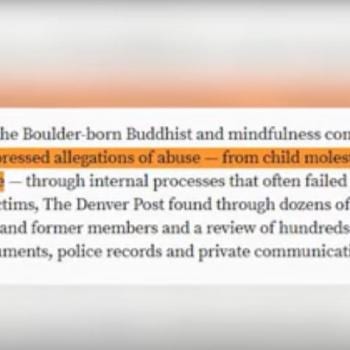Warning: potentially disturbing images and manipulation to follow.
I’m just back from a mini-conference held here in Bristol, and I can only say “my mind was blown.”
Yes, this is going to be an academic post.
Though all of the talks were stimulating, the ‘keynote’ of sorts was on the topic of the use of religious imagery in corporate advertising by Katie Edwards. While her paper focused on Christian imagery, principally Catholic because that seems to have drawn the most outrage, she did mention the use of Jewish, Islamic, and Buddhist images in advertising campaigns. One of the interesting points she made was that ‘general’ Christian imagery didn’t seem overly offensive, such as a model who looks like (typical portrayals of) Jesus with his arms outstretched:

The really offensive ones seemed to attack a particular sect, usually Catholicism, like this:

Also of interest was the fact that the least-used religion was Judaism. This is pretty understandable, I think, given the history of vicious antisemitism in the West and the resulting sensitivity. Islam, however, was the target of an increasing number of ad campaigns, the most provocative of which Ms Edwards didn’t even show us:

Yes. Very offensive. I know. They also have Brainwash Brian, Hole E Christ, and Pedo Pope.
The great point of her presentation was that these ads are meant to be controversial. In fact they often aim to anger people. Why? Free media attention. And tons of it. They can run a few ads in a relatively cheap, low-circulation periodical and with just a few inevitable complaints, the same ad can show up in countless major newspapers, on television, on American Buddhist blogs, the works! And as long as their target audience is at least relatively sympathetic, that is, anti-authoritarian and/or irreligious, they win, big.
An issue raised in the Q&A was whether her academic studies and presentations could be themselves offensive to audiences for perpetuating the offensive images. Hmm, could this blog post itself be offensive? Context is key – as is having a rough understanding of your audience. Academic conferences are usually pretty safe – only groveling students and complete nerds go to those. But a blog? Anybody might read this. Hence, I can only hope that the warning above and the content throughout will alleviate any sense of betrayal or offense.
Buddhists, as anyone who reads theworsthorse knows, tend to get portrayed in a positive light in ad campaigns. But, as a small minority religion, Edwards noted, Buddhism gets a disproportionate amount of advertising attention. Buddhism is highly commodified in the West. I know many bloggers have written about this in the past and hope a few of you can drop links in the comment section below.
In the cases of offending religious beliefs, it should be simply acknowledged that controversy gets attention gets notoriety gets sales. A simpler equation presents itself with some of these ads (like the ice cream ad above): sex sells. Hence the title of the post. Got’cha.
You have to realize that you’re being manipulated when you see these all advertisements. The difference between the commercial ads and an article or academic presentation is that the former diminishes your understanding of the subject. They draw on the emotions of either desire or aversion (or perhaps both) to get a product image or name into your head so that you will buy it. Academic presentations and articles hopefully get you to think about what is happening – in a sense deconstructing the ad by showing the processes that created it and effects it is having on you and others. To be Kantian (if only for a sentence), the former increases heteronomy – being ruled by outside forces- while the latter increases autonomy, self-rule. This is true of so much of our lives: subtle manipulations and unseen prejudices dominate so much of our decision-making that we really need to regularly step back and seek a better understanding of what is going on.
Near the end of the talk, Ms Edwards gave this admonition, “If you see an advert and it really offends you: don’t say anything!” Just walk away. Sage advice, I’d say. Maybe go meditate on your feelings 🙂
And now on to those videos:
And something to really get your heart pumping (don’t watch if you have a heart-condition!):












